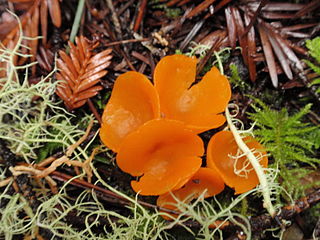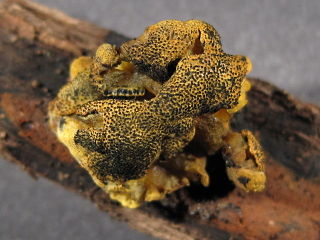
Acanthaceae is a family of dicotyledonous flowering plants containing almost 250 genera and about 2500 species. Most are tropical herbs, shrubs, or twining vines; some are epiphytes. Only a few species are distributed in temperate regions. The four main centres of distribution are Indonesia and Malaysia, Africa, Brazil, and Central America. Representatives of the family can be found in nearly every habitat, including dense or open forests, scrublands, wet fields and valleys, sea coast and marine areas, swamps, and mangrove forests.

Stemonitis is a distinctive genus of slime moulds found throughout the world. They are characterised by the tall brown sporangia, supported on slender stalks, which grow in clusters on rotting wood. The genus was first described by German botanist Johann Gottlieb Gleditsch in 1753. A 2014 estimate suggests that there are 18 species in the genus. Identification within the genus is difficult, and can only be performed with confidence using a microscope or by DNA sequencing. A fossil specimen is known from the mid-Cretaceous.

Hemigraphis is a genus of plants in the family Acanthaceae, consisting of nearly 40 species native to tropical Asia. Hemigraphis is similar to plants the genus Strobilanthes, with some species now placed there. Its native range is Nansei-shoto and from Indo-China to New Guinea.

Sowerbyella is a genus of fungi in the family Pyronemataceae. The genus has a widespread distribution, and contains 17 species found mostly in Europe and China.

Thuemenella is a genus of fungi in the family Hypoxylaceae. The genus was circumscribed in 1898 by Albert Julius Otto Penzig and Pier Andrea Saccardo.
Rostafinskia is a genus of fungi in the Ascomycota phylum. The relationship of this taxon to other taxa within the phylum is unknown, and it has not yet been placed with certainty into any class, order, or family.
Eriosphaeria is a genus of fungi in the family Trichosphaeriaceae. Species in this genus are plant pathogens.

Hygrophoropsis is a genus of gilled fungi in the family Hygrophoropsidaceae. It was circumscribed in 1888 to contain the type species, H. aurantiaca, a widespread fungus that, based on its appearance, has been affiliated with Cantharellus, Clitocybe, and Paxillus. Modern molecular phylogenetic analysis shows that the genus belongs to the suborder Coniophorineae of the order Boletales.
Auriscalpium dissectum is a species of fungus in the family Auriscalpiaceae of the Russulales order. Found in Zaire, it was described as new to science in the year 1979.

Eranthemum is a genus of plants in the family Acanthaceae.
Collaria is a genus of slime molds in the family Lamprodermataceae.
Hygrophoropsis laevis is a species of fungus in the family Hygrophoropsidaceae. Found in Malawi, it was described as new to science in 1985.
Collaria elegans is a species of slime mold in the family Lamprodermataceae.
Physarina is a genus of slime molds in the family Physaraceae.
Metatrichia is a genus of window flies in the family Scenopinidae.
Badhamiopsis is a genus of fungi belonging to the family Physaraceae.

Craterium is a genus of slime molds belonging to the family Physaraceae. The genus has a cosmopolitan distribution.
Diachea is a genus of slime molds belonging to the family Didymiaceae. The genus was first described in 1825 by Elias Magnus Fries.
Enteridium is a genus of slime molds belonging to the family Reticulariaceae.








